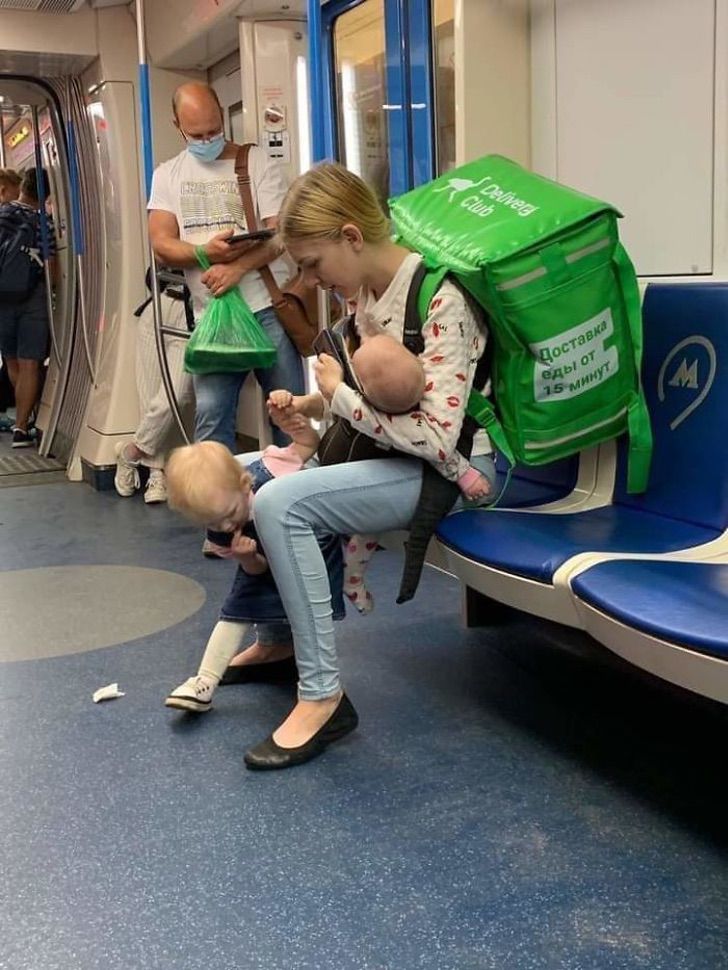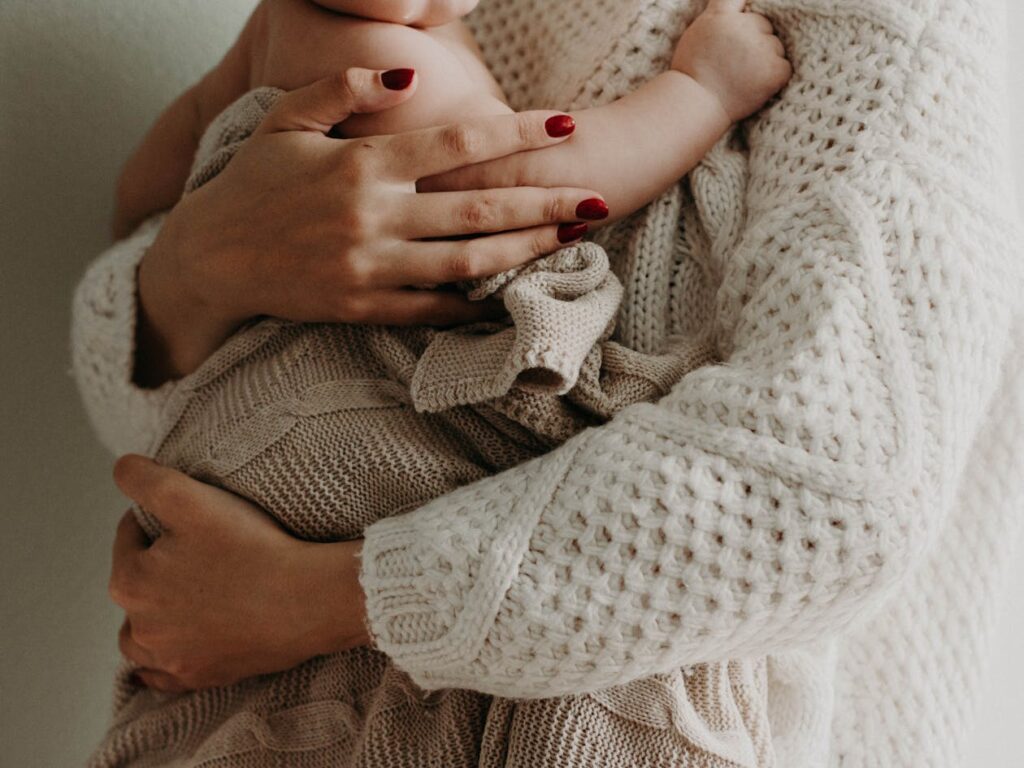Story of a Young Russian Mother Who Balanced Food Deliveries and Childcare on the Subway—A True Example of Strength, Love, and Unwavering Determination

Something about the August 2020 photograph struck viewers immediately. A young woman stood on Moscow’s subway, thermal delivery bag strapped to her back, cradling two small children in her arms. Her face showed exhaustion mixed with determination that resonated with millions who saw the image spread across social platforms worldwide.
Within hours, offers of help flooded social media. Strangers wanted to send money, food, clothing, and support to this apparent symbol of maternal sacrifice. Here was a teenage mother doing whatever necessary to provide for her children, embodying strength that inspired people across continents.
But something wasn’t quite right about this picture-perfect story of struggle and perseverance. Investigators began digging deeper into the background of this viral sensation. What they discovered would challenge everything people believed about social media sympathy stories and the nature of authentic need versus calculated performance.
Was this really a story of determination and love? Or had millions of people been manipulated by something far more calculated? The truth behind Lada Koroleva’s story reveals darker questions about modern charity, social media influence, and how good intentions can sometimes enable harmful behavior.
Meet Lada Koroleva: 19-Year-Old Mother of Two
Lada Koroleva appeared to embody every working mother’s worst nightmare: teenage pregnancy, financial struggle, and the impossible balance between earning money and caring for children. At just 19 years old, she had two daughters and claimed to support them through food delivery work in one of the world’s most expensive cities.
Her story seemed straightforward enough. She’d moved from her hometown to Moscow seeking better opportunities, carrying her children while navigating public transportation to deliver meals. Estranged from family and receiving little support from her young husband, Lada appeared to represent countless women struggling to survive in modern economic conditions.
Social media posts showed her requesting help finding remote work opportunities and better living situations. Her Instagram captions conveyed desperation mixed with hope, asking followers for job suggestions while expressing love for her daughters.
But beneath this surface narrative lay a much more complex reality that would eventually surface through investigative reporting and frustrated volunteers who had tried to help.
When “Yandex Nanny” Was Born
Lada’s first viral moment occurred in March 2019 when someone photographed her pushing a stroller while carrying a delivery bag in Rostov-on-Don. Media outlets dubbed her “courier-mama” and “Yandex Nanny,” creating immediate public sympathy for her apparent struggle.
Television stations picked up the story, leading to appearances on programs like NTV’s “DNK.” Public response was overwhelmingly supportive, with strangers offering snowsuits, diapers, toys, and baby food for her children.
Lada’s social media presence grew rapidly during this period. Posts featuring her children while working received thousands of likes and shares. Her Instagram account developed the sophisticated appearance of an influencer rather than someone genuinely struggling to survive.
Media attention created opportunities for Lada to share her story more widely while building a following that would prove valuable for future fundraising efforts.
Public Rallies Around Young Mother

Public generosity toward Lada initially appeared to validate people’s faith in community support for struggling families. Donations arrived from across Russia and beyond, including essential supplies and monetary contributions for housing and childcare needs.
Television appearances amplified her reach while reinforcing her image as a hardworking mother deserving of assistance. Viewers connected emotionally with her story, seeing reflections of their own struggles or those of family members facing similar challenges.
Social media campaigns encouraged followers to share her posts and contribute to various fundraising efforts. The combination of traditional media coverage and social platform engagement created a powerful sympathy machine that generated substantial donations.
However, warning signs began emerging as volunteers attempted to verify how donated funds were being used and whether Lada’s living situation matched her public claims.
Red Flags Start Appearing
Careful observers noticed contradictions in Lada’s narrative that raised questions about her authenticity. She claimed her husband had been drafted into military service, yet she gave birth to a second child during this period, suggesting ongoing cohabitation.
Public statements about her husband varied dramatically depending on the audience. In interviews, she called him a “bum” who didn’t help with household responsibilities. “My husband doesn’t help with anything, he sits at his computer all the time, playing games. It feels like I have two daughters and a son,” she explained to reporters.
Yet evidence suggested her husband was actively working construction and courier jobs while allegedly coordinating behind the scenes with Lada’s media appearances. The couple appeared to be collaborating on her public image while maintaining separate narratives about their relationship status.
Financial records later revealed that donated money often disappeared without being used for stated purposes like housing or childcare expenses.
Generosity Meets Deception

One of the most damaging allegations against Lada involved housing assistance provided by sympathetic landlords. She received access to affordable rental housing specifically because of her public image as a struggling single mother.
However, her husband secretly moved into the apartment along with a dog, violating rental agreements and deceiving the landlord who had offered reduced rent out of charity. When discovered, this deception undermined trust between Lada and people trying to help her.
Money collected from public donations to cover rental expenses mysteriously disappeared, leaving unpaid bills despite substantial fundraising success. This pattern would repeat multiple times, creating suspicion among volunteers and donors.
Lada eventually issued a public apology for this incident, but continued fundraising efforts suggested she hadn’t learned from the experience.
Fraud Allegations Begin: Volunteers Fight Back
Volunteer coordinator Irina Balayeva became one of the first people to publicly accuse Lada of running an elaborate scam. Balayeva had helped collect 100,000 rubles ($1,375) for apartment expenses, only to discover the money had disappeared when payment time arrived.
“For her it’s just a way to earn [money]. She thought up the story about leaving her husband to get cash,” Balayeva stated, expressing frustration with Lada’s apparent manipulation of donor generosity.
Multiple other volunteers came forward with similar experiences of donations being misused or diverted from stated purposes. Screenshots and documented conversations provided evidence of systematic deception rather than isolated mistakes.
Alexander Gezalov, who runs a mentorship center in Moscow, published detailed Facebook posts documenting his attempts to help Lada and subsequent discovery of her manipulation tactics. His evidence suggested she had collected nearly one million rubles ($13,740) through various sympathy campaigns.
Television Appearances and Growing Skepticism

Rather than backing away from public attention when fraud allegations surfaced, Lada continued making television appearances and granting interviews. Her February 2020 appearance on Channel One’s popular talk show “Let Them Talk” demonstrated her comfort with media manipulation.
Investigative reporting revealed significant discrepancies in her public claims versus documented reality. Most damaging was the discovery from Delivery Club company representatives that Lada hadn’t actually worked as a courier since October 2019, despite posting photos in delivery uniforms throughout 2020.
This revelation undermined the foundation of her public image as a hardworking mother struggling to balance employment with childcare. If she wasn’t actually working delivery jobs, what was the purpose of the subway photos and delivery uniform posts?
Media outlets began questioning their previous coverage and investigating rather than simply amplifying her claims.
Lada Fights Back Against Accusations
When confronted with fraud allegations, Lada attempted to reframe the narrative around public judgment rather than her own behavior. “In general, life has taught [us] to only take help in the form of work. If you accept help with money they’ll judge you and say you’re a scammer. But what’s the scam? The fact that I have two children and I work?”
She claimed to be working night shifts at a flower shop and cleaning apartments while continuing delivery work. Her goal, she insisted, was legitimate employment to support her daughters: “I don’t want [my] children to work from birth.”
However, these defensive statements couldn’t address the documented evidence of misused donations and fabricated work situations that had been exposed by investigators and frustrated volunteers.
Repeated Cycles of Sympathy and Scandal

Analysis of Lada’s behavior over multiple years revealed a consistent pattern of viral photos followed by sympathy campaigns, donations, controversy, and then renewed attempts to generate public support. Each cycle followed similar steps and attracted new audiences unaware of previous scandals.
July 2020 subway photos appeared despite ongoing fraud investigations, suggesting Lada continued operating her sympathy campaigns regardless of criticism. Fresh social media posts requested help finding remote work while maintaining her image as a struggling single mother.
Instagram accounts with unclear connections to Lada began encouraging money transfers to specific bank accounts, though direct links to her remained unverified. These coordinated efforts suggested systematic rather than spontaneous fundraising operations.
Truth Behind the Viral Photos
Investigation revealed that Lada’s viral subway photos were likely staged performances rather than documentation of genuine work situations. Professional-quality composition and strategic timing suggested calculated media manipulation rather than candid moments captured by strangers.
Her sophisticated social media presence, coordinated television appearances, and strategic narrative management indicated media savvy that contradicted her public image as a naive young mother overwhelmed by circumstances.
Evidence suggested possible coordination between Lada and her husband to create and maintain their public personas while generating income through sympathy donations. Their separation claims appeared to be strategic rather than genuine relationship issues.
What About the Children?
Throughout Lada’s media appearances and fundraising campaigns, observers raised concerns about her two young daughters’ welfare. Constant exposure in work-related photos and media interviews created questions about appropriate childcare and privacy protection.
Allegations emerged regarding inadequate medical care, vaccination delays, and nutrition concerns for the children. However, verification of these claims proved difficult due to privacy laws and limited access to family medical records.
Child welfare advocates expressed concern about using children as props in sympathy campaigns and the potential long-term effects of constant media attention on their development and psychological well-being.
When Helping Hurts
Lada Koroleva’s story illustrates how social media can enable sophisticated manipulation of public generosity while creating celebrity status for people willing to exploit sympathy. Her case demonstrates the importance of verifying stories before contributing money and establishing accountability measures for charitable donations.
The ease with which traditional media amplified unverified social media content contributed to the spread of potentially false narratives. News outlets later acknowledged the need for better verification processes when covering viral sympathy stories.
Public desire to help struggling families creates vulnerability to exploitation by people skilled at performing poverty rather than experiencing it. Lada’s case shows how authentic-appearing struggle can mask calculated manipulation designed to generate income and fame.
Systematic approaches to helping families in need prove more effective than individual charity responses to viral social media campaigns. Professional social services and established nonprofit organizations provide better accountability and long-term support than sporadic donations to internet celebrities.
The story of Lada Koroleva serves as a cautionary tale about modern charity in the digital age, reminding us that the most compelling stories of struggle aren’t always the most genuine ones deserving our support.
Loading...

